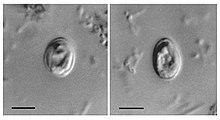Cryptosporidia
| Cryptosporidia | ||||||||||||
|---|---|---|---|---|---|---|---|---|---|---|---|---|

C. parvum oocysts |
||||||||||||
| Systematics | ||||||||||||
|
||||||||||||
| Scientific name | ||||||||||||
| Cryptosporidium | ||||||||||||
| Tyzzer , 1907 |
Cryptosporidium ( Cryptosporidium ) are a genus of single-celled parasite that often calves and occasionally humans , but in addition to 40 other vertebrates infected . They belong to the Apicomplexa and are closely related to Plasmodium , the causative agent of malaria , and Toxoplasma gondii , the causative agent of toxoplasmosis . Human pathogenic cryptosporidia are subject to mandatory reporting in Germany .
distribution
Cryptosporidia occur worldwide and are mainly transmitted through contaminated drinking water . In Milwaukee ( USA ) in 1993, one of the largest epidemics caused by cryptosporidia over 300,000 infected people was observed. Although precise information is missing, it is estimated that 3.5% of the population of Europe excrete the spores, mostly without becoming ill themselves.
features
The oocysts are round and very small at just under 5 micrometers (the smallest oocysts among the apicomplexes ). The sporozoites only measure up to 4 micrometers.
Life cycle
In the host's intestine , the oocysts release the sporozoites, which penetrate the brush border of the intestinal cells, nest there in a parasitophoric vacuole and develop further into trophozoites and meronts . The meronts divide asexually into 8 merozoites I, which infect new host cells, where a second generation of merozoites is formed from each merozoite. The sex cells (gamonts) develop from the resulting second generation of merozoites. The fertilization of female macrogametes by male microgametes creates a zygote and finally an oocyst. Two types of oocysts are formed: around 80% are thick-walled and are excreted with the faeces, the remaining 20% are thin-walled and remain in the host, where they cause the host to re-infect. The oocysts are very resistant and, under favorable conditions (humidity and temperature), can remain infectious for several months. They are insensitive to many disinfectants .
Harmful effect
The infection ( cryptosporidiosis ) usually heals by itself after a few weeks. The symptoms observed are mild fever , dizziness, abdominal cramps, and weight loss. However , it can lead to chronic diarrhea in people with a weakened immune system (e.g. AIDS ) . It is estimated that an estimated 3% of all AIDS-related deaths are cryptosporidia as the immediate cause of death.
It is assumed that immunization can take place via ingestion of a few cysts via raw food or domestic animals in areas of distribution, so outbreaks can then occur in a lighter form or do not occur at all.
Cryptosporidia also pose an infection risk for reptiles ( e.g. in terrariums) ( C. saurophilum / varanii, C. serpentis ).
Diagnosis
Cryptosporidium oocysts can be detected in stool smears with the help of various staining methods (e.g. modified Ziehl-Neelsen staining ). Detection by immunofluorescence or copro antigen detection via ELISA is also possible.
species
- Cryptosporidium andersoni
- Cryptosporidium bailey
- Cryptosporidium bovis
- Cryptosporidium cervine
- Cryptosporidium canis
- Cryptosporidium cuniculus
- Cryptosporidium ducismarci
- Cryptosporidium fayeri
- Cryptosporidium felis
- Cryptosporidium fragile
- Cryptosporidium galli
- Cryptosporidium hominis
- Cryptosporidium marcopodum
- Cryptosporidium meleagridis
- Cryptosporidium molnari
- Cryptosporidium muris
- Cryptosporidium parvum
- Cryptosporidium ryanae
- Cryptosporidium saurophilum
- Cryptosporidium serpentis
- Cryptosporidium suis
- Cryptosporidium ubiquitum
- Cryptosporidium wrairi
- Cryptosporidium xiaoi
Therapy in human medicine
Symptomatic therapy for an infection with Cryptosporidium species consists of intravenous fluids and, in the case of diarrhea, administration of loperamide or opium tincture and octreotide . The antiparasitic therapy is done with paromomycin or albendazole , alternatively with azithromycin or not authorized in Germany nitazoxanide .
Reporting requirement
In Germany, direct or indirect evidence for human pathogenic Cryptosporidium sp. in particular subject to reporting according to Section 7 (1) number 11 of the Infection Protection Act , provided that the evidence indicates an acute infection in humans.
Web links
literature
- Dönges J (1988): Parasitology. With special consideration of human pathogenic forms ; Thieme Stuttgart
- H. Mehlhorn and G. Piekarski: Outline of parasite science. Heidelberg, 6th edition 2002.
- Kayser et al .: Medical Microbiology , 12th edition 2010., Thieme Verlag
Individual evidence
- ↑ cryptosporidien.de - Cryptosporidia in reptiles
- ^ Marianne Abele-Horn: Antimicrobial Therapy. Decision support for the treatment and prophylaxis of infectious diseases. With the collaboration of Werner Heinz, Hartwig Klinker, Johann Schurz and August Stich, 2nd, revised and expanded edition. Peter Wiehl, Marburg 2009, ISBN 978-3-927219-14-4 , p. 291.

